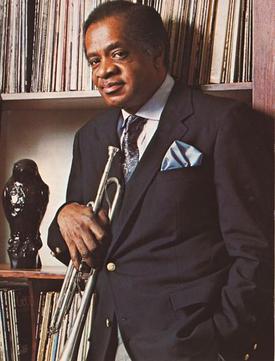Donald Byrd facts for kids
Quick facts for kids
Donald Byrd
|
|
|---|---|
 |
|
| Background information | |
| Birth name | Donaldson Toussaint L'Ouverture Byrd II |
| Born | December 9, 1932 Detroit, Michigan, U.S. |
| Died | February 4, 2013 (aged 80) Dover, Delaware, U.S. |
| Genres | Jazz, funk, jazz-funk, soul, R&B |
| Occupation(s) | Musician |
| Instruments | Trumpet, flugelhorn, vocals |
| Years active | 1954–2013 |
| Labels | Blue Note, Prestige, Verve, Columbia, Transition |
| Associated acts | Pepper Adams, Gigi Gryce, Jackie McLean, Hank Mobley, Dexter Gordon, The Blackbyrds |
| Education | Wayne State University (B.A.) Manhattan School of Music |
Donaldson Toussaint L'Ouverture Byrd II (December 9, 1932 – February 4, 2013) was an American trumpet player and singer. He was famous for playing jazz and R&B music. Donald Byrd played with many other jazz musicians. He was one of the few "hard bop" jazz artists who also successfully explored funk and soul music. As a bandleader, Byrd helped start the career of famous pianist Herbie Hancock.
Contents
Donald Byrd's Life and Music Journey
Early Years and Musical Start
Donald Byrd was born in 1932 in Detroit, Michigan. His family was a middle-class African-American family. His father was a minister who believed strongly in education. Donald's mother loved jazz music and her brother gave him his first trumpet.
He went to Cass Technical High School and even played with the famous musician Lionel Hampton before he finished school. His first professional recording was in 1949. After playing in a military band for the United States Air Force, Byrd went to college. He earned a music degree from Wayne State University and a master's degree from Manhattan School of Music.
While still in school, he joined a famous jazz group called the Jazz Messengers. After leaving that group in 1956, he played with many other top jazz artists. These included John Coltrane, Sonny Rollins, Thelonious Monk, and Herbie Hancock.
Mentoring Herbie Hancock
Donald Byrd's first regular band was a group he led with saxophonist Pepper Adams. They played together from 1958 to 1961. One of their live performances was recorded on the album At the Half Note Cafe.
Byrd's 1961 album Royal Flush was the first album for Herbie Hancock on the Blue Note label. Herbie Hancock has said that Donald Byrd was a very important person in his early career. Byrd took the young pianist "under his wing" when Hancock was a new musician in New York. He even let Hancock sleep at his apartment for several years.
Hancock also shared that Byrd helped him in many other ways. Byrd encouraged him to record his first album. He also connected Hancock with Mongo Santamaria, who made Hancock's song "Watermelon Man" a huge hit. Later, Byrd told Hancock to join Miles Davis's famous band.
Byrd gave Hancock one of the most important pieces of advice: never give away his publishing rights for his music. When Blue Note Records wanted Hancock to record his first solo album, they tried to get him to give up these rights. But Hancock remembered Byrd's advice and refused. Because of this, Hancock kept the rights to his music. When "Watermelon Man" became a hit, Hancock received a lot of money. He used his first big check to buy his first car, a 1963 Shelby Cobra, which Byrd also suggested. Hancock still owns this car today!
Exploring New Sounds
Around 1969, with his album Fancy Free, Donald Byrd started to change his musical style. He moved away from traditional jazz and began to record jazz fusion and rhythm and blues. He worked with the Mizell Brothers, who were producers and writers. Together, they created Black Byrd (1973), which became Blue Note's best-selling album for many years. The main song from the album became a hit on the R&B and pop music charts.
The Mizell brothers also helped Byrd create other popular albums like Street Lady, Places and Spaces, and Stepping into Tomorrow. These albums were also very successful.
In 1973, Donald Byrd helped create the Blackbyrds. This was a jazz fusion group made up of students from Howard University, where Byrd taught music. The Blackbyrds had several big hits, including "Happy Music" and "Walking in Rhythm."
During the 1980s, while teaching at North Carolina Central University, Byrd formed another group called the "125th St NYC Band." They recorded three albums. One of their songs, "Love Has Come Around," became a popular disco hit.
Donald Byrd was also a dedicated teacher. He earned his PhD in music education in 1982. He taught at many universities, including Rutgers University, Howard University, and Cornell University. Later in his career, Byrd returned to playing more traditional jazz music.
Donald Byrd lived in Teaneck, New Jersey. He passed away on February 4, 2013, in Dover, Delaware, at the age of 80.
Discography
Donald Byrd released many albums as a leader and also played on albums for other musicians. Here are some of his notable albums as a leader:
- 1959: Off to the Races
- 1960: Fuego
- 1960: At the Half Note Cafe
- 1961: Royal Flush
- 1963: A New Perspective
- 1970: Electric Byrd
- 1973: Black Byrd
- 1973: Street Lady
- 1975: Stepping into Tomorrow
- 1976: Places and Spaces
- 1981: Love Byrd
He also played as a sideman (a supporting musician) on many albums with famous artists like:
- Art Blakey
- Kenny Burrell
- John Coltrane
- Lou Donaldson
- Dexter Gordon
- Herbie Hancock
- Hank Mobley
- Sonny Rollins
- Horace Silver
- Jimmy Smith
- Thelonious Monk
- Wes Montgomery
See also
 In Spanish: Donald Byrd para niños
In Spanish: Donald Byrd para niños


